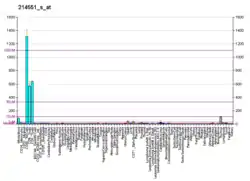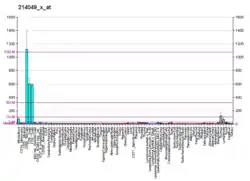CD7
CD7 (Cluster of Differentiation 7) is a protein that in humans is encoded by the CD7 gene.[5]
| CD7 | |||||||||||||||||||||||||||||||||||||||||||||||||||
|---|---|---|---|---|---|---|---|---|---|---|---|---|---|---|---|---|---|---|---|---|---|---|---|---|---|---|---|---|---|---|---|---|---|---|---|---|---|---|---|---|---|---|---|---|---|---|---|---|---|---|---|
| Identifiers | |||||||||||||||||||||||||||||||||||||||||||||||||||
| Aliases | CD7, GP40, LEU-9, TP41, Tp40, CD7 molecule | ||||||||||||||||||||||||||||||||||||||||||||||||||
| External IDs | OMIM: 186820 MGI: 88344 HomoloGene: 4471 GeneCards: CD7 | ||||||||||||||||||||||||||||||||||||||||||||||||||
| |||||||||||||||||||||||||||||||||||||||||||||||||||
| |||||||||||||||||||||||||||||||||||||||||||||||||||
| |||||||||||||||||||||||||||||||||||||||||||||||||||
| |||||||||||||||||||||||||||||||||||||||||||||||||||
| |||||||||||||||||||||||||||||||||||||||||||||||||||
| Wikidata | |||||||||||||||||||||||||||||||||||||||||||||||||||
| |||||||||||||||||||||||||||||||||||||||||||||||||||
Function
This gene encodes a transmembrane protein which is a member of the immunoglobulin superfamily. This protein is found on thymocytes and mature T cells. It plays an essential role in T-cell interactions and also in T-cell/B-cell interaction during early lymphoid development.[5]
See also
Clinical significance
CD7 can be aberrantly expressed in refractory anaemia with excess blasts (RAEB) and may confer a worse prognosis.[8] Also, a lack of CD7 expression could insinuate mycosis fungoides (MF) or Sezary syndrome (SS).[9]
References
- GRCh38: Ensembl release 89: ENSG00000173762 - Ensembl, May 2017
- GRCm38: Ensembl release 89: ENSMUSG00000025163 - Ensembl, May 2017
- "Human PubMed Reference:". National Center for Biotechnology Information, U.S. National Library of Medicine.
- "Mouse PubMed Reference:". National Center for Biotechnology Information, U.S. National Library of Medicine.
- "Entrez Gene: CD7 CD7 molecule".
- Lee DM, Patel DD, Pendergast AM, Haynes BF (August 1996). "Functional association of CD7 with phosphatidylinositol 3-kinase: interaction via a YEDM motif". International Immunology. 8 (8): 1195–203. doi:10.1093/intimm/8.8.1195. PMID 8918688.
- Subrahmanyam G, Rudd CE, Schneider H (January 2003). "Association of T cell antigen CD7 with type II phosphatidylinositol-4 kinase, a key component in pathways of inositol phosphate turnover". European Journal of Immunology. 33 (1): 46–52. doi:10.1002/immu.200390006. PMID 12594831. S2CID 26388891.
- Ogata K, Kakumoto K, Matsuda A, Tohyama K, Tamura H, Ueda Y, Kurokawa M, Takeuchi J, Shibayama H, Emi N, Motoji T, Miyazaki Y, Tamaki H, Mitani K, Naoe T, Sugiyama H, Takaku F (October 2012). "Differences in blast immunophenotypes among disease types in myelodysplastic syndromes: a multicenter validation study". Leukemia Research. 36 (10): 1229–36. doi:10.1016/j.leukres.2012.05.006. PMID 22682984.
- Stevens SR, Baron ED, Masten S, Cooper KD (October 2002). "Circulating CD4+CD7- lymphocyte burden and rapidity of response: predictors of outcome in the treatment of Sézary syndrome and erythrodermic mycosis fungoides with extracorporeal photopheresis". Archives of Dermatology. 138 (10): 1347–50. doi:10.1001/archderm.138.10.1347. PMID 12374541.
Further reading
- Stillwell R, Bierer BE (2002). "T cell signal transduction and the role of CD7 in costimulation". Immunologic Research. 24 (1): 31–52. doi:10.1385/IR:24:1:31. PMID 11485208. S2CID 23446615.
- Baker E, Sandrin MS, Garson OM, Sutherland GR, McKenzie IF, Webber LM (1990). "Localization of the cell surface antigen CD7 by chromosomal in situ hybridization". Immunogenetics. 31 (5–6): 412–3. doi:10.1007/BF02115022. PMID 1695199. S2CID 2959698.
- Schanberg LE, Fleenor DE, Kurtzberg J, Haynes BF, Kaufman RE (January 1991). "Isolation and characterization of the genomic human CD7 gene: structural similarity with the murine Thy-1 gene". Proceedings of the National Academy of Sciences of the United States of America. 88 (2): 603–7. Bibcode:1991PNAS...88..603S. doi:10.1073/pnas.88.2.603. PMC 50860. PMID 1703303.
- Yoshikawa K, Seto M, Ueda R, Obata Y, Notake K, Yokochi T, Takahashi T (1991). "Molecular cloning of the gene coding for the human T cell differentiation antigen CD7". Immunogenetics. 33 (5–6): 352–60. doi:10.1007/BF00216694. PMID 1711009. S2CID 20322510.
- Ware RE, Scearce RM, Dietz MA, Starmer CF, Palker TJ, Haynes BF (December 1989). "Characterization of the surface topography and putative tertiary structure of the human CD7 molecule". Journal of Immunology. 143 (11): 3632–40. PMID 2479685.
- Osada S, Utsumi KR, Ueda R, Akao Y, Tsuge I, Nishida K, Okada J, Matsuoka H, Takahashi T (1988). "Assignment of a gene coding for a human T-cell antigen with a molecular weight of 40,000 daltons to chromosome 17". Cytogenetics and Cell Genetics. 47 (1–2): 8–10. doi:10.1159/000132494. PMID 3258561.
- Aruffo A, Seed B (November 1987). "Molecular cloning of two CD7 (T-cell leukemia antigen) cDNAs by a COS cell expression system". The EMBO Journal. 6 (11): 3313–6. doi:10.1002/j.1460-2075.1987.tb02651.x. PMC 553785. PMID 3501369.
- Maruyama K, Sugano S (January 1994). "Oligo-capping: a simple method to replace the cap structure of eukaryotic mRNAs with oligoribonucleotides". Gene. 138 (1–2): 171–4. doi:10.1016/0378-1119(94)90802-8. PMID 8125298.
- Lee DM, Schanberg LE, Fleenor DE, Seldin MF, Haynes BF, Kaufman RE (1996). "The mouse CD7 gene: identification of a new element common to the human CD7 and mouse Thy-1 promoters". Immunogenetics. 44 (2): 108–14. doi:10.1007/s002510050097. PMID 8662072. S2CID 29837811.
- Bevec T, Stoka V, Pungercic G, Dolenc I, Turk V (April 1996). "Major histocompatibility complex class II-associated p41 invariant chain fragment is a strong inhibitor of lysosomal cathepsin L". The Journal of Experimental Medicine. 183 (4): 1331–8. doi:10.1084/jem.183.4.1331. PMC 2192513. PMID 8666891.
- Leta E, Hou Z, Lederman L, Jung LK (October 1996). "Interaction between the extracellular domain of CD7 and concanavalin A: a clue to the identity of the ligand for CD7". Cellular Immunology. 173 (1): 15–21. doi:10.1006/cimm.1996.0247. PMID 8871597.
- Lee DM, Patel DD, Pendergast AM, Haynes BF (August 1996). "Functional association of CD7 with phosphatidylinositol 3-kinase: interaction via a YEDM motif". International Immunology. 8 (8): 1195–203. doi:10.1093/intimm/8.8.1195. PMID 8918688.
- Suzuki Y, Yoshitomo-Nakagawa K, Maruyama K, Suyama A, Sugano S (October 1997). "Construction and characterization of a full length-enriched and a 5'-end-enriched cDNA library". Gene. 200 (1–2): 149–56. doi:10.1016/S0378-1119(97)00411-3. PMID 9373149.
- Slentz-Kesler KA, Hale LP, Kaufman RE (February 1998). "Identification and characterization of K12 (SECTM1), a novel human gene that encodes a Golgi-associated protein with transmembrane and secreted isoforms". Genomics. 47 (3): 327–40. doi:10.1006/geno.1997.5151. PMID 9480746.
- Steegmaier M, Yang B, Yoo JS, Huang B, Shen M, Yu S, Luo Y, Scheller RH (December 1998). "Three novel proteins of the syntaxin/SNAP-25 family". The Journal of Biological Chemistry. 273 (51): 34171–9. doi:10.1074/jbc.273.51.34171. PMID 9852078.
- Pace KE, Lee C, Stewart PL, Baum LG (October 1999). "Restricted receptor segregation into membrane microdomains occurs on human T cells during apoptosis induced by galectin-1". Journal of Immunology. 163 (7): 3801–11. PMID 10490978.
- Lyman SD, Escobar S, Rousseau AM, Armstrong A, Fanslow WC (February 2000). "Identification of CD7 as a cognate of the human K12 (SECTM1) protein". The Journal of Biological Chemistry. 275 (5): 3431–7. doi:10.1074/jbc.275.5.3431. PMID 10652336.
- Rotem-Yehudar R, Galperin E, Horowitz M (August 2001). "Association of insulin-like growth factor 1 receptor with EHD1 and SNAP29". The Journal of Biological Chemistry. 276 (35): 33054–60. doi:10.1074/jbc.M009913200. PMID 11423532.
- Rossi MI, Yokota T, Medina KL, Garrett KP, Comp PC, Schipul AH, Kincade PW (January 2003). "B lymphopoiesis is active throughout human life, but there are developmental age-related changes". Blood. 101 (2): 576–84. doi:10.1182/blood-2002-03-0896. PMID 12393702.
External links
- CD7+protein,+human at the U.S. National Library of Medicine Medical Subject Headings (MeSH)
- Human CD7 genome location and CD7 gene details page in the UCSC Genome Browser.
This article is issued from Wikipedia. The text is licensed under Creative Commons - Attribution - Sharealike. Additional terms may apply for the media files.





